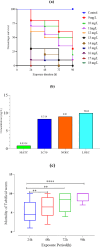Carbonsulfan-induced physiological, histopathological, and ultrastructural alterations in tubifex tubifex (müller, 1774)
- PMID: 40685402
- PMCID: PMC12277422
- DOI: 10.1038/s41598-025-11463-3
Carbonsulfan-induced physiological, histopathological, and ultrastructural alterations in tubifex tubifex (müller, 1774)
Abstract
The present study evaluates the toxicological effects of carbosulfan by observing the mortality, behavioural responses, and alteration of oxidative biomarkers such as CAT, SOD, and MDA. The mortality rate of tubificid worms exposed to the toxicant differed substantially (p < 0.05) from the control group at all concentrations throughout the experiment. The p-value less than 0.05 indicates that the changes in these biomarkers were statistically significant. The severity of behavioural changes included irregular movement, decreased clumping proclivity, mucus production, and a surge in autotomy. Long-term exposure to two sub-lethal doses of CBSF (0.831 mg/L and 1.632 mg/L) resulted in the disintegration of longitudinal muscles of tubificid worms, the continuity of longitudinal muscle (LM) parallel to the gut, and ruptured mucus channel (MC) from the anterior portion of the worm. In addition, scanning electron microscope images revealed the alteration of epidermal lesions, setal anomalies, and clitellar swelling due to CBSF exposure. The oxidative stress biomarkers catalase (CAT), superoxide dismutase (SOD) and malonaldehyde (MDA) increased with increasing concentrations of CBSF, i.e., 0.831 mg/L and 1.632 mg/L. The maximum elevation of CAT, SOD and MDA was observed on the 14th day. In addition, IBRv2 analysis demonstrated that tissue biomarkers were extremely sensitive to the toxicity of CBSF, and extended exposure might result in major health consequences, such as acute toxicity in tubificid worms because of increased oxidative stress biomarkers. The log-normal curve of species sensitivity distribution (SSDs) depicted the ecotoxicological risk assessment through 96 h LC50, i.e., 8.31 mg/L. Strong interactions between CBSF and key stress biomarker enzymes were shown by molecular docking experiments, which interfered with the enzymes' activities and might have caused oxidative stress. Interactions with cytochrome c oxidase indicated disruption of the process by which cells produce energy. The findings highlight the need for more investigation to completely understand the sensitivity of tubificids to environmental pollutants and the long-term impacts of pesticide exposure on aquatic health and ecosystem stability.
Keywords: Autotomy; Behavioural changes; Benthic tubificid worm; Carbosulfan; Sub-lethal toxicity.
© 2025. The Author(s).
Conflict of interest statement
Declarations. Competing interests: The authors declare no competing interests. Conflict of interest: The research was conducted without any commercial or financial relationships that could be interpreted as a conflict of interest, as declared by the authors.
Figures











References
-
- Wu, W. & Ma, B. Integrated nutrient management (INM) for sustaining crop productivity and reducing environmental impact: A review. Sci. Total Environ.512, 415–427 (2015). - PubMed
-
- Saha, S. et al. Chronic effects of Diazinon® exposures using integrated biomarker responses in freshwater walking catfish, Clarias batrachus. Appl. Sci.11, 10902. 10.3390/app112210902 (2021).
-
- Mukherjee, D. et al. Silent threats beneath the surface: unraveling the impact of organophosphate toxicity on fish. Sci. Total Environ.985, 179725. 10.1016/j.scitotenv.2025.179725 (2025). - PubMed
MeSH terms
Substances
Grants and funding
LinkOut - more resources
Full Text Sources
Miscellaneous

